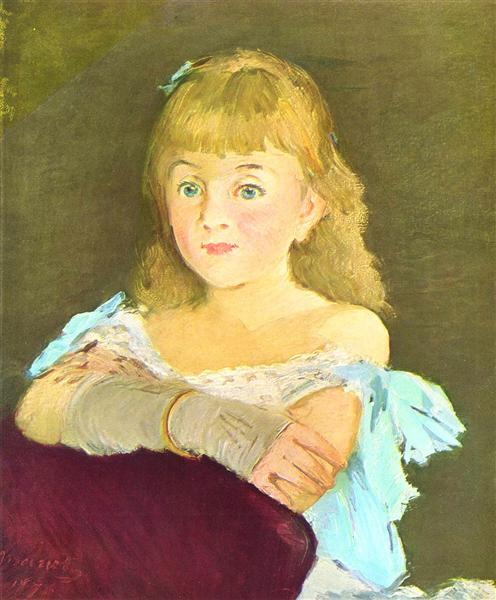Descrição
A seminal figure in the transition between Realism and Impressionism, Édouard Manet captures in his work "Portrait of Lina Campineanu" (1878) a spark of intimacy and modernity that articulates his unique artistic vision. In this portrait, Manet depicts Lina Campineanu, a woman who, although not widely recognized in the annals of art history, becomes a muse for the master. The work establishes a visual paradigm that combines the subtlety of traditional portraiture with the boldness of modernity that characterizes Manet's work.
The composition is predominantly vertical, giving Lina’s figure a solid and proud presence. Her slightly bent posture and direct gaze at the viewer suggest a dynamic and energetic personality. Manet uses the loose brush technique and limited but effective palette, highlighting Lina’s skin through a subtle contrast with the dark background that surrounds her. This dark setting not only highlights her figure, but also speaks to Manet’s interest in lighting and its effect on the perception of subjects, a recurring theme in his work.
The colours that Manet chooses are a mix of terracotta, beige and dark brown tones, which enhance the warmth of Lina's skin and convey a sense of closeness. The way the light develops on her face and dress reveals Manet's mastery in the representation of volume and texture, creating an almost tactile effect on the canvas. Her clothing, embellished with details in lighter tones, not only serves to define her figure, but also emphasises her contemporary elegance, a prominent feature in many of the female figures that migrate from the master's workshop.
The dark background of the portrait contrasts with the luminosity of the subject, a visual device that Manet uses to direct the viewer’s gaze towards Lina. This choice can also be interpreted as a comment on modernity in the artistic representation of women, where light and shadow play equally important roles, challenging the conventional narratives of his time. Through this technique, the artist achieves a quiet emotionality that invites reflection on Lina’s identity and place in 19th-century society.
It is interesting to note that in this work, Manet moves away from his more provocative style that he employed in other works such as Olympia or Breakfast on the Grass. Here, in his treatment of the female figure, there is a tone of respect and admiration that offers emotional complexity. Lina's beauty lies in her simplicity, an echo of Manet's aim to capture contemporary life in an honest and authentic manner. This portrait is a manifestation of Manet's interest in real people and their stories, as opposed to the romantic idealism that dominated his time.
"Portrait of Lina Campineanu" stands, therefore, not only as a portrait of a specific woman, but as a symbol of the evolution of painting in the context of the social and cultural changes of the 19th century. It is a visual testament to how Manet not only portrayed his contemporaries, but also explored the relationship between artist and subject, a theme that continues to resonate in contemporary art. In Manet's work we find not just a portrait, but a story of human connection, an exploration of light and shadow, and a reflection of the time in which he lived.
KUADROS ©, a famous painting on your wall.
Hand-made oil painting reproductions, with the quality of professional artists and the distinctive seal of KUADROS ©.
Painting reproduction service with satisfaction guarantee. If you are not completely satisfied with the replica of your painting, we will refund 100% of your money.

